WING is located on 29/F of The Wellington, one floor below the famous VEA and is in fact also under the same Executive Chef and Owner Vicky Cheng. Despite his French cooking background, through VEA, he got so passionate on Chinese cuisine and decided to open this restaurant. Different from the fusion style of VEA, WING is a contemporary, but still, Chinese restaurant in essence.
Entering through some nicely designed screen partitions, we have the banquette seats in the corner of the main dining area. The décor is neat and modern, with a large slab of marble having beautiful bluish patterns in the middle of the emerald velvet wall at the back, and windows looking out to the Central skyline at the side.
Before the start of the meal, the server presented us the welcome drink. With the passing of ‘Major Cold’, the last of the 24 Chinese Solar Terms, the coldest time of the year has passed, and people begin to get ready for the new year and spring. The Eight Treasure Tea 八寶茶 is a special concoction to warm our body, with a bit of sourness to start our appetite.
I have the Standard 6-Glass Wine Pairing ($980) to go with the Seasonal Tasting Menu ($1,780 each). The restaurant has prepared some Cashew Nuts as snacks, having complex flavours as the cashew has been seasoned with 24 different Asian herbs.
Beginning with four small dishes as starters, the first is Geoduck with Yunnan Chili and Bull Kelp 象拔蚌配雲南皺皮椒及海茸. The fresh geoduck has a thick cut, sweet in taste with good umami from the sauce. The bull kelp is a type of seaweed with nice texture, and together with the slight spiciness from the finely shredded Yunnan chili create a wonderful feast of flavours.
The second small dish is Drunken South African Abalone 醉南非鮑魚. The large abalone has been marinated in 20-year Chinese Huadiao Wine and Wu Jia Pi, with a touch of star anise. The aged and fragrant wine flavours are elegant, seeped well into the abalone, which has a good bite but not rubbery.
The third small dish is Chili Oyster and Century Egg 香辣生蠔伴皮蛋. The Japanese raw oyster has been mixed with homemade chili oil, giving the soft, creamy oyster a kick of spiciness but not over-dominating its freshness. The homemade century egg has a translucent egg white and a slight gooey yolk. It has far less ammonia taste than those purchased in market and when mixed together with the chili oil are highly complementary.
The fourth small dish is Smoked Eggplant with Homemade Sour Sauce 煙熏酸汁茄子. A testimony of the chef’s skills, the small pieces of eggplant are stacked together firmly, and even using chopsticks to pick it up the pieces did not fall apart. Brushed with some homemade sour sauce, the nice aromatic smokiness of the eggplants and the tempting acidity certainly appeals to our palate.
The first wine which pairs with the four dishes is a Champagne from Domaine Francoise Martinot, Bistrotage B.14+1 Extra Brut. An organic Blanc de Noirs, the wine has a complex nose, with slight oxidation notes, ripe fruit and zesty palate which goes well even with the spicy chili oil and oyster.
An extra starter I pre-order is Stinky Tofu Tiger Prawn Toast 臭豆腐虎蝦多士 ($180 addition per person). Freshly deep-fried, the stinky tofu has only a slight stinky smell, enough to remind us of the traditional HK street food but not repelling other diners who might not be used to it. With a beautiful golden brown colour, the tofu has a great texture, with a bit of dried shrimp roes and coriander paste on the top, sensational to enjoy with the homemade bean paste and sweet sauce. Affixed is the prawn toast, with the minced tiger prawn very bouncy in texture and umami in taste, the toast also crunchy and not oily. My favourite on the night and a must order in my opinion.
The second wine which pairs with the stinky tofu is Vincent Dureuil-Janthial Rully 2019. The Chardonnay has a nice lemon zest, white peach, and honey notes, also good minerality of chalk. Its richer texture and good acidity balances well with the deep-fried dish, while the chalky characters a perfect fit with the stinky tofu.
Next comes Chinese Almond Soup with Egg White and Japanese Yam 杏汁蛋白淮山湯. The Japanese yam has a nice soft texture, with a layer of silky-smooth egg white on the bottom. The server then pours in some hot almond soup, made from chicken stock and juice squeezed from abundance of sweet apricot kernel. The delicate taste is elegant, without any overpowering flavours but every element is well-integrated and in synch. Very delicious.
For the main courses, Threadfin Ma Yau with Mandarin Peel and Fermented Black Bean 陳皮豆豉蒸馬友. The threadfin is Chef Cheng’s favourite fish, a seasonal delicacy with its bigger size, good and fatty, fetching a very high price in the market. Steamed together with fermented black beans and mandarin peel, the rich flavours of the fish are enriched by the fragrance of the mandarin peel together with the savoury taste of fermented black beans. With some chopped spring onion and shredded chili to add to both taste and colour, this is another of my favourites on the night.
To pair with the fish is Keller Riesling Kabinett 2020 from Rheinhessen in Germany. Lightly sweet, the wine has good acidity to balance with the fatty fish while the sweetness is complementary with the savoury notes of the black beans.
Next comes Alaskan King Crab Leg with Crab Roe, Garlic, and Crispy Cheung Fun 蒜蓉蟹粉蒸皇帝蟹腳配煎腸粉. It brings a big wow when presented with the large king crab carapace, before the server helps to split the dish for us. The meaty king crab leg is sweet in taste, and the chef has taken the meat of the body, mixing with crab roe from mud crab to prepare a sauce. Together with the crab vinegar, it is very delicious. The rice rolls have a crunchy crust, soaking up all the essences and flavours. Another great dish.
Then a chef come to our table with a trolley, showing us another extra dish I pre-order, the Signature Crispy Chicken 招牌脆皮雞 ($1,200 for whole chicken). Knowing that we still got a number of dishes to come, I ask the chef to only cut half of the chicken to serve, taking the rest home. The chicken has been marinated and aged for five days, with complex flavours but not overpowering the original taste of the chicken. It is then deep-fried to give a wonderfully crispy skin. Good in taste and requiring lots of effort to prepare, but in my opinion a bit over-priced.
To pair with the chicken, the Chateau Musar 1998 is served, a nice red wine from Lebanon, with its earthy notes matching very well with the flavours of the chicken, and the lighter tannin also goes better with chicken meat. Another great food and wine matching.
Then it is Baby Pigeon in Sugarcane 煙熏蔗汁乳鴿. The baby pigeon has been dry-aged for three days to intensify the flavours and brushing with sugarcane juice on the skin to give a slight sweetness. Using the bagasse to smoke the pigeon, the aromas are very pleasant, with the pigeon juicy and flavourful. Frankly I would rate this even better than the crispy chicken earlier. It is so good that even though we are already very full, both of us can finish our portion of half the pigeon.
For the vegetable, the chef prepares Daikon in Sour Soup Pot 酸湯蘿蔔煲. The chef uses Japanese daikon with some Taiwanese tomatoes and the homemade pickled mustard green to prepare a sour soup, with refreshing acidity to cleanse the palate, reducing the heavy sensation in the stomach to allow space for the rice. I also like the sweetness of the daikon. Another delicious dish.
The final dish before dessert is Fish Maw and Morel Mushroom in Abalone Sauce Rice 鮑汁羊肚菌花膠飯. The thick fish maw has been beautifully braised, very soft and melting, completely coating the mouth with the richness. The abalone sauce gives great flavours to the rice, and together with the fragrance of the morel mushrooms, is filling and delicious. I ended up finishing also my mother’s portion as she was so full already.
The wine paired with the rice is a special one, Xiao Pu 小圃 聚 MV.5. A small boutique winery in China Ningxia, the owner has a passion in making natural wines with minimal intervention. This wine is an interesting blend of Cabernet Sauvignon with Pinot Noir, with good fruit and not too astringent, good match with the fish maw and rice.
For dessert, first is Mignardises 餐後茶點, including Black Sesame Rice Dumplings and Lotus Seed Paste Cream Donut. The rice dumplings have a nice chewy texture, with the black sesame aromatic and not super sweet. The donuts have the creamy lotus seed paste fillings which is sweeter but not excessive. The dough is nicely deep-fried but not oily. Both are delicious.
Next it is Snow Gum and Osmanthus with Coconut Sorbet 桂花雪膠配椰子雪芭. The snow gum is commonly known as ‘bird’s nest for commoners’, a type of fungus that is grown in high altitude, with a nice bite. The sweet soup is enriched by the coconut sorbet, and the osmanthus gives a nice fragrance, making the dessert multi-dimensional in flavours.
The dessert wine to pair is Chateau Coutet 2007. This Barsac sweet wine has a honey and floral aromas, with good balance of sweetness and acidity making the wine not cloying and quite refreshing, good to pair with the desserts which are not too sweet.
Finishing with some Fresh Fruit, the server pulls a cart in front of us, introducing the three types of fruit on the day: Iwate Golden Apple, Wakayama Persimmon, and Australian Cherry Plum. All the fruit are very refresh and sweet, a nice ending for a fantastic meal.
Service is very good, with the staff friendly and attentive. While the servers do explain each of the course, I believe they can perhaps go into more details so that the diners can understand more the ingredients and techniques the chef has put into the dishes. The bill is $6,904 and while it is not cheap, it is still worth paying a visit to experience how Vicky works his magic in Chinese cuisines, especially if you like his creations in VEA.





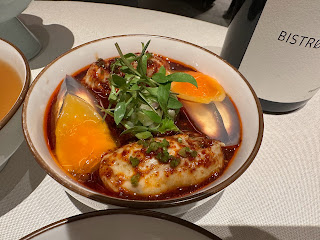
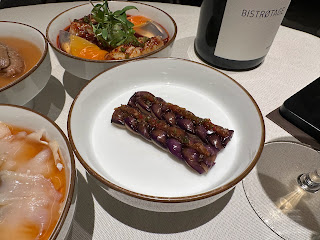

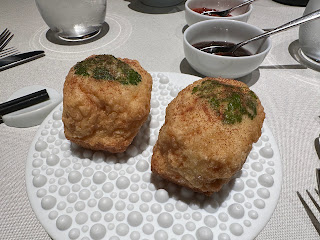






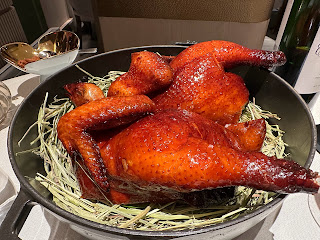












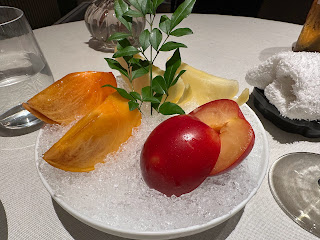
沒有留言:
張貼留言